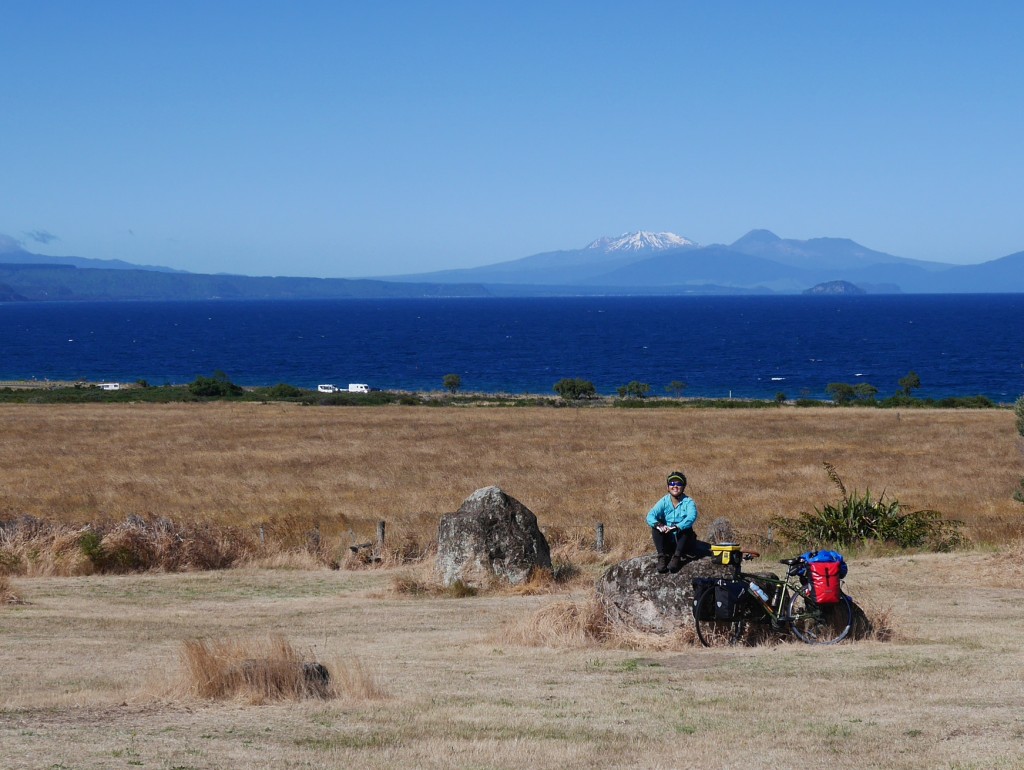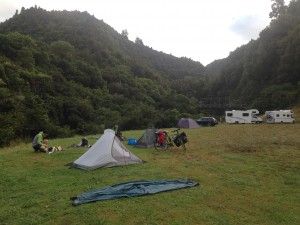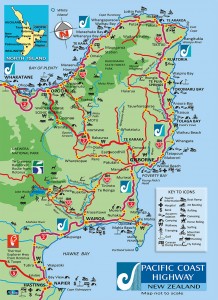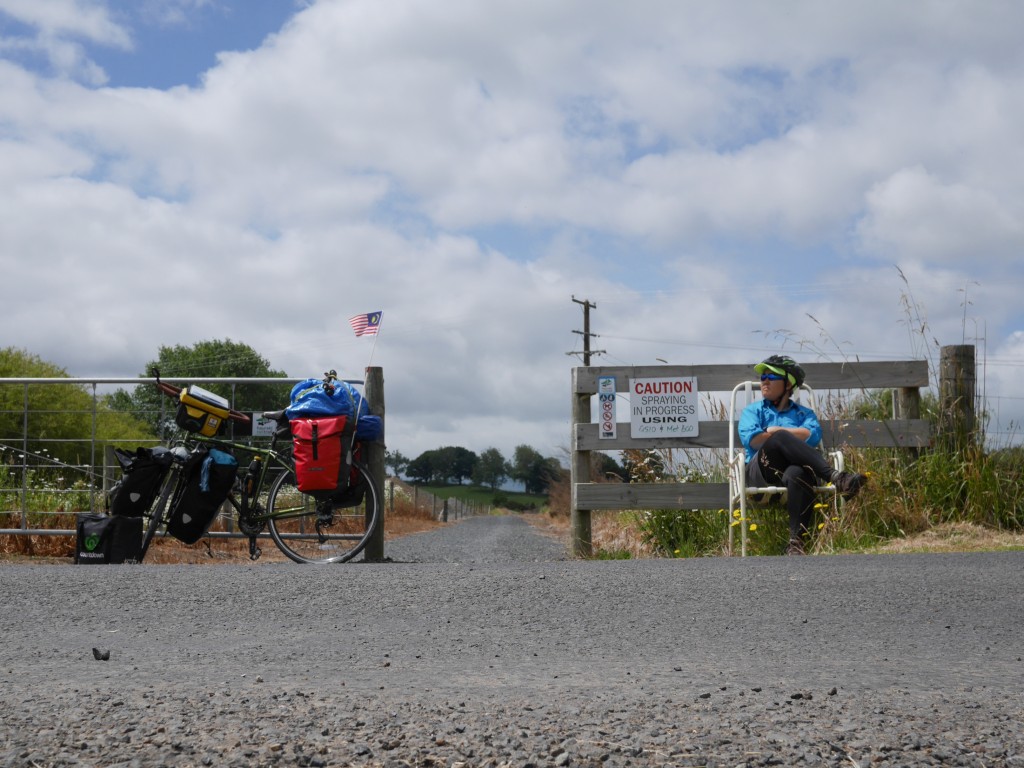Cycle touring in New Zealand – Observations, Thoughts, and Tips.
In December 2015, I cycled in the North Island of New Zealand for about 4 weeks. Before that I also toured South Island for two weeks in a campervan. I was in the North Island for the rest of my time (4 months), travelling in a car, and did a few mountain biking day trips.
My cycling tour in NZ is not very extensive, and this article was written based on my combined experience of both cycling and driving NZ roads. Most of my observations will be about North Island, but I will put in some thoughts about South Island based on my driving experience there.
To put this into further context, my previous cycling experience was mostly in Malaysia, Thailand and Cambodia. A lot of my observations will be done in comparison to my experience cycling in these Asian countries.
My cycle route in the North Island was as follows:
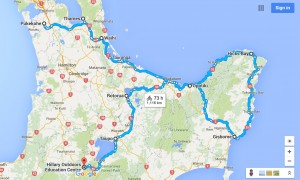
Pukekohe (South Auckland) – Thames – Katikati – Tauranga – Whakatane – Opotiki – around the East Cape – Gisborne – Opotiki via H2 – Whakatane – Rotorua – Taupo – Tongariro National Park.
-
NZ IS FULL OF HILLS!
Imagine you have a piece of paper in your hand. Scrunch up that paper, and smooth it out again. North Island will look a bit like that crinkly piece of paper – there are not so many major mountain ranges in North Island, but hills are everywhere. This means that there could be many steep inclines and descents, repeatedly throughout the day. This fact was very obvious to me after the long flat plains of Thailand and Cambodia.
As for the mountainous areas like the Central Plateau of North Island, and much of South Island, they have long gradual climbs to go over high passes followed by rolling flat plains.
In short, if you want to gain some guns, cycle in NZ. And get bigger cogs.
-
NZ roads are built for cars.
NZ is a very car centric country, and the road network is built for them. Almost everyone drives a car, and the bus network beats the train network in terms of connectivity around the country. Also, each township is usually only connected by one direct route. Unlike in Asia, where you can scurry into villages or secondary roads off the main highway for some cycling peace, in NZ you will probably only have the same route option cycling as you would driving. Sometimes you can choose a less prominent highway, but these routes will definitely be longer and more circuitous. My point is – you will be sharing a lot of your cycling with most other cars.
The North Island is more heavily populated hence traffic on the roads is heavier. You will be sharing the road with a lot of private vehicles and trucks. As for the South Island, there are even less route option between towns. The traffic that you have to deal with in South Island will be a lot of campervan vehicles and tour buses.
-
NZ roads are narrow and winding in general
Multi lane highways in NZ only exist near big cities like Auckland and Christchurch. Otherwise, almost all other roads around the country are single lane. These single lane roads usually have a maximum speed of 100km/h, which means a lot of times you will have cars zipping past you quite quickly.
Closely tied to point 2, most roads here have some shoulder to cycle on, but the size of it does vary. Sometimes I was forced to ride on the line, or even on the main road itself. When the road goes over a bridge or culvert, the shoulder can become non-existent, and you need to pre-empt well and cut into main traffic. So unlike in Asia, where car drivers might anticipate bicycles or motorcycles, here in NZ car drivers are pretty much king of the road.
NZ is also known to have some of the worst car accidents, and that’s because many of their roads are narrow and winding. I have cycled a section where once I turned a corner, I was basically in a blind spot and a car behind me can swerve around that same corner in a high speed and not see me in time. It was also an incline. I was lucky because the campervan right behind me slowed down and kept behind me the whole way around the corner, and they cheered me on once they drove past me.
From my observations, there is plenty of awareness and patience for cyclists in urban areas – nice cycle paths, appropriate signages, etc. But once you are out on the road, cars just want to gun it at their 100km/h.
-
Prepare for long stretches without services.
This is a huge contrast for me between NZ and SE Asia. In SE Asia, you can find food almost everywhere – roadside stalls, street food, shops, etc. In NZ, you can only find food in cafes or restaurants in main townships. In between these townships there could be an odd petrol station or café, but they are hard to anticipate. Some of these towns are so small there may only just be a small convenience store. It is best to have all the food you need for the day when you start out.
This is particularly true in South Island, as the distances between towns are much bigger.
It is also best to stock up on food in a bigger town with a large supermarket (Countdown, Pak n Save, New World). Some small towns might have small grocery stores or dairies, but their choices are limited and more expensive. Cafes and takeaways can be nice occasionally, but the cost does add up quickly.
-
Cyclists have to follow road rules too.
I generally follow road rules as much as possible as if I am driving, eg. stopping at red lights. I have been told that cyclists have been fined by the NZ police for not stopping at STOP signs. So since hearing that I’ve done that too J
-
Plenty of bike shops all over NZ
On the flipside, there are bike shops almost everywhere in the North Island. Mountain biking is a huge part of tourism here. Locals are also big on commuting and road biking. Except for the smallest towns, even most medium size towns will have one or two bike shops. Which means you don’t have to stock up on so many spares, tools or accessories because it is not too far to get to the next town or too difficult to hitch a ride. Cycling is very popular in NZ, so most bike shops are quite well equipped even for touring equipment.
There are plenty of bike shops in South Island, but mainly in the bigger towns. And again, the distances between these towns are bigger, so preparedness is more crucial down south.
Wild camping is a contentious issue in NZ. They have a history of dealing with campervan campers who wild camp and trashing their campsites (not just with trash but with human waste). Hence in the North Island you will find that many designated free camping spots are only for self-contained vehicles, ie. Campervans that have their own toilets.
There are plenty of paid campsites. There are holiday parks all over NZ and they usually have well serviced campsites for average cost of $22, with proper toilets and showers, kitchen, power, the full works. And then there are also DOC campsites, which are maintained by Department of Conservation. They charge a minimal fee of $6 – $10, and these sites usually just have a drop toilet and a tap /river for water. DOC campsites however are usually nestled in National Parks or forest reserves so it is rare to come across one in the North Island. There are also rest areas along roads for motorist to pull over for a break, but a lot of these sites don’t have toilets or water.
The other thing with wild camping in the North Island is that most of the land up here is either an urban public area, or it is private. A lot of farmland. Hence if you wild camp in the North Island most probably you are trespassing private property.
I have met cycle tourers who have wild camped. One solo female cyclist did it often and was occasionally invited into the farmers’ houses for tea. One guy I met does it by stealth – sneaking into bushes or trees on the edge of towns.
As for myself, I wild camped once with a fellow cyclist, but that was in one of the most remote corners of North Island (northern tip of the East Cape). I have camped in free campsites that are designated only for self-contained vehicles, and I was not chased away, but this was also in the East Cape, which is much more remote, less touristy, and local councils are a bit more lax.
When I am stopping over a big town like Tauranga or Rotorua I usually paid for a hostel bed, which is just a few dollars more than a campsite. I am personally not comfortable wild camping near urban areas due to the higher amount of human traffic. As a rule as well I prefer not to wild camp on private property because I usually need to poop like clockwork in the mornings and pooping on someone else’s land didn’t seem very nice.
Also, I like arriving early in campsites, taking my time to set up, chill, and make a leisurely dinner. Stealth camping will mean cycling late into the evening, setting up quickly in the dark, and packing up early in the morning before it gets too bright.
I may end up being a bit more confident and loose about my rules if I cycled longer. Afterall, accommodation in general is quite pricey in NZ (camping or hostels). So choose your own adventure.
As for South Island, there is plenty of wilderness all over the shop. My guess is even if you end up camping on farmland, the land is so vast and so remote there are less people and authorities patrolling around.
There are a few smartphone apps available to find campsites in NZ. The one I use is called Camping NZ. Sections of the NZ map, or even the whole country itself, can be downloaded for offline use. The app also lists information like prices and facilities for each campsite. Highly recommended.
-
Cycling is a great way to meet people.
I would say that compared to my time cycling and post-cycling, I encountered much more friendly and generous people when I was cycling. There are A LOT of backpackers in NZ, and most of them are in vans and cars. I suppose being on a bike puts you in a unique position and out of the stereotypes of a backpacker.
On Xmas day a lady stopped at the side of the road and waited for me to climb up a hill. Then she flagged me down and invited me to a Xmas lunch at her church. Another time I was having lunch inside a café, and a burly looking farmer walked into the café and purposely welcomed me to NZ.
NZ in general is pretty popular for cycle-tourers. I met lots of European cyclists who came over just to cycle the country over the summer. There’s also the occasional world tourer. I cycled with a Dutch cyclist for about 4 days and learn heaps from him as he has done extensive touring around the world. I cycled with a Kiwi guy for 2 days and had lots of interesting conversations about NZ history and culture.
Recommendations
-
Use the Warmshowers network
I used Warmshowers for the first time in NZ, and had a great experience. There are many hosts in NZ and can be quite handy when staying over somewhere urban. Granted it could be a game of luck as a I had a lot of potential hosts who were away on summer holidays. Some hosts can be far out of the way from your route. But they are definitely a great source of local knowledge and friendship to tap into.
I had two weeks to kill; I looked at the map and decided that this funky corner of North Island seemed interesting and looks about the right timeline. So that was how I decided to ride the East Cape. That turned out to be a wonderful decision because East Cape is the best kind of country for cycle touring.
The East Cape is one of the most remote corners of North Island as it is a detour away from the major tourist towns. Many of those who travel East Cape are locals. The route winds around a beautiful and rugged coastline, with many beautiful beaches. East Cape was and still is strong Maori country, so one will pass lots of maraes (Maori community halls) and encounter local Maoris. (A popular NZ local made movie “Boy” was filmed here, depicting the story of a young Maori boy growing up in this region. Very charming film). The road has much less traffic compared to the rest of North Island, and very hilly but also very scenic. Accommodation and services are few and far between in these parts, which adds to its rustic charm.
I would recommend East Cape as a must-do for cycle touring in the North Island.
-
Put on thicker tyres
The tyres on my bike are 1.5 inch road touring tyres, best for road riding. As a result I missed out on a lot of trail riding, which I reckon is NZ’s best thing with cycling. There are many cycle trails all over the country, and you can plan your routes using these trails to get off the highway. But many of them are on dirt or gravel trails, which tend to be tricky for a heavily loaded, thin tyred bike.
I would not go all out to recommend mountain bike tyres, but a middle range that can be nice on road and steady on dirt will be good
4.Put up a flag
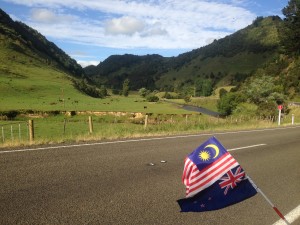
For the fun of it I brought along a small Malaysian flag, fashioned a long pole out of three smaller ones. I attached it to the rear of my bike. I thought it was a good way to make myself look bigger and more visible on the road. Also it looked good in pictures. Eventually I bought a NZ flag and added that on too.
I learned that the flags were a great conversation starter. A few people approached me to ask what country am I from, or made a guess (Japan, China, etc) (3 people said it right the first time). My Warmshowers host later suggested that I tilt the flag pole 45 degrees away from my bike towards traffic. This turned out to be a great idea as a huge signal for vehicles to stay far away from me. In fact many cars swerve intentionally away from the pole, and we guessed mostly for fear of the pole scratching their car.
5. If I were to do it again
Related to point 3 – If I were to plan my trip again, this is what I would do. I would travel in a van or car, and carry my bike around with me. I will have both road tyres and mountain bike tyres. I would travel in between destinations, put on mountain bike tyres to run the awesome bike trails, or put on road bike to do a nice road tour like the East Cape. (Having the car will also mean I can carry the extra gear for hiking and other shenanigans I like to do).
I say this because I personally am very impressed with the mountain bike trails in NZ, and I enjoyed them more than the road touring. Many of these bike trails wind through beautiful forests and remote areas, and nature being NZ’s best feature this is a better ride, at least in the North Island. They have many different grades of bike trails, but most of them are manageable even for someone like me who is relatively inexperienced on mountain bikes.
In fact, when I get more time on a mountain bike and am able to invest in bikepacking gear, I would definitely bikepack the NZ Cycle Trail, which is a network of mountain bike trails from North to South NZ.
